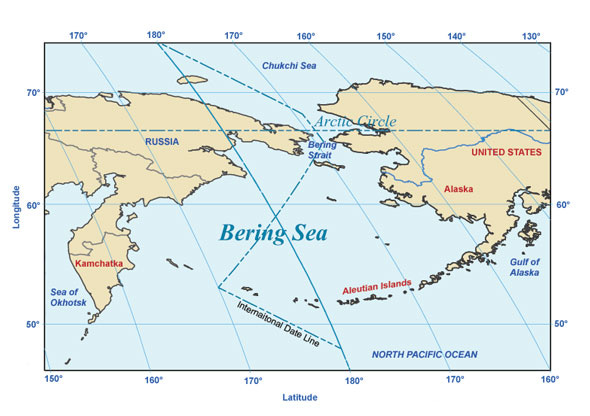Maine is generally regarded as the first place in the United States to see the sun rise each day, and since I lived there 15 years ago I’ve been vaguely aware of a tension between Acadia National Park and the town of Lubec as to where exactly the first sunrise occurs. I finally got around to researching this further and I can now tell you that determining the place in the United States where the sun first rises is not so easy, largely because it requires both trigonometry as well as answers to three deceptively simple questions:
What is a day?
What is a place?
What is the United States?
While I have tried to be as liberal as possible in my answer to each of these questions, I have nevertheless excluded the two US South Pole research stations and ~800 foreign military bases from being considered “part of the US”, amongst other reasons because including them would mean that the sun never sets on the US empire. With this disclaimer out of the way, I now present eleven places which have a strong case for being the first place to see the sunrise in the United States, only four of which are in Maine.

If Midnight Sun Counts, Then…
Utqiagvik, Alaska (71.26° N, 156.79° W°) has the first sunrise in the United States.
Located on Alaska’s north slope, Utqiagvik is the most northerly settlement on the North American continent. Residents experience midnight sun from May 11 through July 31, so it seems unreasonable to suggest that any other place in the United States experiences sunrise “before” them during that summer period.
If You Recognize The 180-Degree Meridian as the Start of a Day, Then…
Pochnoi Point, Alaska (51.96° N, 179.77° E°) has the first sunrise in the United States.
Pochnoi Point, located in the chain of Aleutian Islands that stretch west from Alaska, is the point of land in the United States most immediately west of the 180th meridian, giving it longitudinal coordinates in the Eastern Hemisphere. Historically, this would have made it one of the first places in the world to see the sunrise, however, when the United States purchased Alaska from Russia in 1867, they moved Alaska to the east side of the international date line, so now Pochnoi Point is one of the last places on earth to see the sunrise. That’s not all: the Julian calendar (used in Russia) and Gregorian calendar (used in the United States) were almost two weeks out of sync when the US purchased Alaska, so Alaskans went to sleep on Friday, October 6, 1867 and woke up the next morning on Friday, October 18.

If Time Zones, Not the 180-Degree Meridian, Determine the Start of a Day, Then…
Wake Island (19.28° N, 166.65° E) has the first sunrise in the United States.
Wake Island is the only US territory in the UTC+12 time zone, so from a time zone perspective the eastern shores of the island are the first place in the US to see the sunrise each morning. But good luck getting there: while there are some 200 beds on the island for US military personnel and various contractors, there is no permanent population and traveling there is heavily restricted.

If People Have to Live There For It to Count, Then…
Saipan Island (15.27° N, 145.83° E) has the first sunrise in the United States.
The largest island in the Commonwealth of the Northern Mariana Islands, Saipan is also the easternmost point of land controlled by the United States in the UTC+10 time zone, a time zone shared with Vladivostok, Russia, and Sydney, Australia (there are no US territories in UTC+11). While inhabitants don’t have representation in US Congress and can’t vote for president, they do get to see the sunrise about 15 hours earlier than Washington D.C. each morning, and surely that’s got to count for something. Right?
If You’re a Sucker For Marketing, Then…
Guam (13.59° N, 144.96° E) has the first sunrise in the United States.
Less than 100 miles SSW of Saipan lies Guam, the southernmost island in the Northern Mariana chain. Guam’s’ unofficial slogan is “Where America’s Day Begins”, but I can’t figure out any legitimate claim that Guam has to this title since Sapian, which shares the same time zone and territorial status as Guam, is situated further east and experiences sunrise between one and seven minutes earlier than Guam every single day of the year.

If Direction of Travel, Rather than Longitude, Determines East, Then…
Point Udall, US Virgin Islands (17.76° N, 64.57° W) has the first sunrise in the United States.
Longitude is not the only convention to determine how far east or west something is on Earth. There’s a second method called direction of travel, in which you calculate the shortest route between the center of an entity and a constituent part of that entity to determine the direction between them. Since the shortest route from the center of the United States to Guam, Saipan, and Wake Island is achieved by traveling west, each of these islands would be considered in the far west of the United States, and therefore would be among the last places in the US to see the sunrise, regardless of what time zone they are in. In fact, by direction of travel, Guam is the absolute furthest west point in the United States, which is why just 13 miles from the easternmost point of Guam where America’s day allegedly begins (by longitude), Point Udall, on the westernmost point of Guam has a monument claiming to be the last place that America’s day ends (by direction of travel).
So what is the easternmost point in the United States when using direction of travel? That would be the Point Udall Millennium Monument in the US Virgin Islands (UTC-4). Udall Point is named after Stewart Udall, Arizona Congressman and Secretary of the Interior under President Kennedy, while Point Udall in Guam is named after his brother, Mo Udall, who succeeded Stewart and served Arizona in Congress for 30 years. Upon Mo’s death in 1998, Bill Clinton remarked that, given the two monuments, the sun never sets on the legacy of Mo Udall. This, however, is not true because throughout the entire year there exists a 90 to 150 minute period centered around 09:00 UTC when the sun has already set in Guam but not yet risen in the US Virgin Islands. During this time the sun does not shine on Mo Udall, or on any other American for that matter.
If You’re Talking About the Continental United States and it is Close to the Equinox, Then…
West Quoddy Head, Lubec, Maine (44.82° N, 66.95° W) has the first sunrise in the United States.
Because the Earth spins on an 23.5 degree axis, the poles are usually tilted towards or away from the sun, which creates seasons and varying length of days. On the equinoxes, however, the sun appears directly overhead for everybody on Earth—we all get 12 hours of daylight and 12 hours of night—and sunrise sweeps across the planet parallel to lines of longitude. First published in a 1972 edition of Yankee Magazine, New Englander Blanton C. Wiggin calculated that West Quoddy Head—the easternmost point of land in the continental United States—only sees the first sunrise for about three weeks around each equinox—from March 7 to March 24 and again from September 19 to October 6. During the rest of the year, the latitude and elevation of other sites create a slight edge over West Quoddy Head.

If It’s Summer Time, Then…
Mars Hill (45.52° N, 67.81° W) in Mars Hill, Maine has the first sunrise in the United States.
As spring turns to summer in the northern hemisphere, then sun appears further north in the sky and dawn sweeps across Earth at a sharper angle from NW to SE. Because of this, the sun rises earlier the further north you travel, and if make your way up to the Arctic Circle it won’t set at all. From around March 25 to September 18, Mars Hill, located in the town of Mars Hill, Maine, sees the sunrise before Quoddy Head. While Mars Hill is in the northern reaches of Maine, it’s not Maine’s northernmost point: the 1,750 foot elevation of Mars Hill gives it an edge over the lower lying regions of Maine that lie further north.

If It’s Still Summer Time But The High Hills of Carleton County, New Bruniswick are Blocking the Sun, Then…
Mount Katahdin in Baxter State Park, Maine (45.90° N, 68.92° W) has the first sunrise in the United States.
Standard sunrise/sunset calculations don’t account for topographical interference on the horizon, which is why the aforementioned Blanton C. Wiggins and Judson D. Hale updated Wiggins’ original Maine sunrise calculations to account for hills that might occasionally delay the sunrise in certain locations. They concluded that for a few days each summer when the Mars Hill sunrise is delayed because the sun rises over some hills located across the border in New Brunswick, Canada, Maine’s highest point, Mount Katahdin (5,270 feet), sees the sunrise before anywhere else in the state. Katahdin is 65 miles southwest of Mars Hill and 120 miles northwest of West Quoddy, but it’s elevation gives it a ~4 minute advantage over surrounding lower lying regions. I was able to verify some of this using free tools available from The Photographer’s Ephemeris. Timeanddate.com is currently working on a geospatial API that will “provide data for an accurate 360° horizon for any location on Earth”, which may make these sorts of nuanced sunrise calculations easier for layfolk in the not too distant future.
If It’s Winter Time, Then…
Cadillac Mountain in Acadia National Park, Maine (44.35° N, 68.22° W) has the first sunrise in the United States.
In the winter, the sun rises earlier in the south, so between October 7 and March 6 the summit of Cadillac Mountain (1,527 feet), located 70 miles southwest of West Quoddy Head in Acadia National Park sees the first sunrise. Wiggins and Hale posited that for the period directly surrounding the solstice (November 29 - Jan 11) Mars Hill edges out Cadillac Mountain for first sunrise, but I can’t quite figure out why, as the solstice is the time when being further south would have the greatest advantage and there aren’t really any hills east of Cadillac Mountain that could delay the sunrise.

If It’s Winter Time and Conditions for Atmospheric Refraction Are Just So, Then…
Sankaty Bluff in Siasconset, Massachusetts (41.28° N, 69.97° W) has the first sunrise in the United States.
In the predawn hours of January 1, 2000, three people arranged a conference call on their cell phones to settle a bet. While Cadillac Mountain and West Quoddy Head had long been feuding about where the first sunrise of the millennium would take place, Vladimir Strelnitski, Director of the Maria Mitchell Observatory on Nantucket, hypothesized that a 117 foot high sandy bluff on the eastern edge of Nantucket, located significantly southwest of the Maine locations, might see the sunrise a bit earlier. While West Quoddy Head was furthest east, Cadillac Mountain was the highest, and Nantucket was the furthest south: each of those factors contribute positively to an early sunrise in the wintertime.
But there was another factor at play as well: Because the Earth’s atmosphere acts like a prism, we see the sun rise up to a few minutes before the sun actually rises above the horizon, as diagramed below:

Our ability to see beyond the horizon is impacted by weather conditions: colder temperatures, higher humidity, and higher barometric pressure all increase atmospheric refraction, and it’s because of this margin of error that estimated sun rise times never include seconds. While Maine is generally colder than Nantucket, humidity and barometric pressure tend to be higher at sea level, and this, as well as clear skies, were on Nantucket’s side the morning of the new millenium.
As reported in Cape Cod Times, on January 2, 2000:
“And at 7:04 a.m., give or take a few seconds, Strelnitski was oohing and ahhing on his cell phone over the sunrise, while Lubec residents were still in the dark, he said. A half-minute later, the sun rose on Bar Harbor's 1,534-foot Cadillac Mountain. One minute and three seconds after it hit Sankaty, dawn finally came to West Quoddy Head in Lubec.”
Strelnitski freely admitted that it may have been the atmospheric conditions that gave Nantucket the edge over Cadillac Mountain thar morning. And while most people gathered at West Quoddy Head conceded that they were not the first to see the sunrise that morning, others were quick to sew doubt. Ron Pesha, a member of the Lubec Millennium Committee, wondered aloud as to whether “rays of sunlight may have fallen first on the unoccupied Porcupine Mountain, in Lubec territory”, referring to a nearby mountain nearby that conveniently nobody was at the top of that morning.
So while some days the sun may rise on Katahdin before Mars Hill, or on Santaky Bluff before Cadillac Mountain, or on Saipan before Guam, there will always be some guy named Ron reminding you that unless you are standing in one place, talking on a phone with a friend who is standing on the other, we will never actually know.
Thanks for reading,
–- Grif


